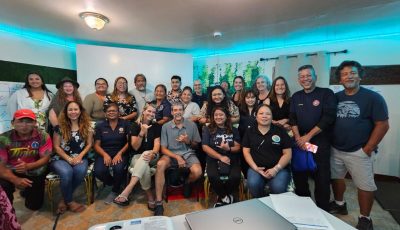The struggles of CHCC
On Jan. 15, 2009, then-governor Benigno R. Fitial signed House Bill 16-9 into Public Law 16-51. The purpose of P.L. 16-51 is “to establish a public corporation for healthcare and related public health services known as the Commonwealth Healthcare Corporation.”
On Oct. 24, 2011, a little more than two years and 10 months later, the CHCC was formally established with the appointment of a board of trustees and a chief executive officer. The government retains control and oversight of the public corporation through legislative processes and oversight; the corporation operates independently to serve the public purposes as articulated in the enabling legislation.
CHCC faced many problems in its first year. There were four major problems in the first year of operations: 1) Finances, 2) Lack of planning for the CHCC, 3) Inexperience of the management team to deal with the magnitude of the financial shortfalls and the problems resulting from a lack of planning for the CHCC before it became operational on Oct. 24, 2011, 4) Finding of the Centers for Medicare and Medicaid of several already existing Immediate Jeopardy threats to patient care and patient safety.
The start-up problems of CHCC were directly attributable to the lack of financial resources. If monies were available, there would not have been any delayed payroll payments to clinicians and other CHCC employees. With money, CHCC would have been able to purchase an abundance of medical supplies, laboratory reagents, and pharmaceuticals. CHCC, with money, would have been able to repair equipment and/or purchase new equipment which the CMS had already identified as Immediate Jeopardy concerns. Additionally, CHCC would have been able to pay vendors, including paying the millions due to vendors from when CHCC was the Department of Public Health. In fact, if monies were readily available then, CHCC would not have inherited a billing and collection staff which was placed on “austerity,” which in turn led to a backlog of bills to insurers, including the CMS Medicare and Medicaid programs. The billing backlog inherited by the CHCC was at least over 2 years old. The CNMI government was well aware of the critical financial situation the CHCC was facing.
The reality was that the Legislature of the CNMI provided $5 million in seed capital for CHCC. However, that $5 million was not immediately available so the amount of $200,000 was paid monthly to CHCC. The amount for payroll alone every two weeks was nearly $2 million. This meant that there was $0.0 in the bank at the inception of the CHCC. Then-Lt. Gov. Eloy S. Inos and who was acting governor understood the situation and provided funding to make one payroll. However, the absence of funding plunged the CHCC into a “valley of despair.”
The establishment of a public corporation requires considerable planning. Unfortunately, when CHCC was inaugurated on Oct. 24, 2012, the lack of planning for CHCC became evident. The lack of transition planning, coupled with the financial difficulties of the CNMI government, made for a challenging implementation of CHCC as a new corporation. No articles of incorporation were prepared. No draft by-laws for the operation of the board were prepared. Applications for designation of CHCC as a provider of healthcare services for Medicare and Medicaid were prepared. There was no financial assessment or plans were put in place either by the administration or the Legislature. There was no statement of beginning balances, cash, assets, liabilities, and other financial information. The chairman of the Committee on Health of the CNMI Legislature was Rep. Ralph Torres, who held the same position as senator.
In the first year of operation of CHCC, the financial condition was so dire that the board of trustees ordered the closure of the lone public dental clinic located at hospital and staffed by at least 15 employees. On the day, CHCC sought the assistance of the Legislature for funding support. I personally invited members of the Legislature, including the chairman of the Committee on Health, Ralph Torres, for a tour of the hospital and to meet with the staff, including the medical staff. Rep. Ralph Torres never showed up nor expressed concern over the impending closure of the dental clinic.
In that same year, the board of trustees, due to the dire financial condition of CHCC also ordered the closure of the Community Guidance Center that was providing essential services to patients. CHCC invited the chairman of the Committee on Health for a tour of the hospital and the Community Guidance Center with the intention of requesting legislative support. Rep. Ralph Torres was a no-show. Two other members of the Legislature did show up and CHCC appreciated their attendance.
Going into the second year of operation of the CHCC, the board of trustees was in discussion of separating the operations and services of the public health component from the hospital. It was a proposal that as CEO I did not support. The situation placed the CEO and the board at odds. For the third time, the CHCC invited Sen. Ralph Torres for a meeting at CHCC in order to discuss not just the separation of public health from the hospital but the critical financial condition CHCC was in. Sen. Ralph Torres showed no interest and was a no-show at the meeting despite the repeated invitations extended to him.
Despite the unwillingness of the Legislature to bail out CHCC from its critical financial condition, CHCC decided to move forward by turning to the Marianas Public Land Trust for a temporary loan in the amount of $3 million. MPLT, after much deliberation and justification by CHCC for a loan, approved it. CHCC also sought the assistance of the Centers for Medicare and Medicaid Services. Through a collective team effort, the State Medicaid Agency, Region IX of the U.S. Department of Health and Human Services, the Centers for Medicare and Medicaid Services, the CHCC, there was an increase in the Medicaid funding based on the CMS approved use of the CPE Methodology. The CPE Methodology, as provided for in the rules and regulations for Medical Assistance Program, enables the appropriations to the CHCC, loans to the CHCC (e.g. MPLT loan), and other authorized funding, which when expended, to count as the local match for Medicaid funding. To date, the Legislature has not appropriated funding specifically as match required by Medicaid of the 45:55 match.
Enrollment of Eligible Medicare Patients into the Part B Medical Insurance Program helped improved the financial condition of the hemodialysis services. CHCC provides hemodialysis services on an outpatient basis to over 100 patients per month. CHCC determined that there were at least 10 patients that were enrolled in the Part A program for hospital services but not enrolled in the Medicare Part B program, even though the patients were eligible for participation. The participation in the Medicare Part B requires the patient to pay a premium. The over 10 patients which were identified were enrolled in the Medicare Part B increased the amount of reimbursements for hemodialysis services from about $700,000 to $840,000 a year.
When CHCC was inaugurated on Oct. 24, 2011, starting on that date, CHCC owed in excess of $5 million to the Commonwealth Utilities Corp. Analysis conducted on the cost of utilities included electric power, water, wastewater, solid waste, and telecommunications. These were prior years cost the Legislature refused to provide funds for despite repeated requests by the heads of the Department of Heath prior to becoming CHCC.
During its first year CHCC initiated plans to upgrade the CT scanner from a single slice to a 16-slice scanner. The 16-slice scanner enables a clinician to pinpoint tumors for radiotherapy, provides detailed images of torn kidney or bone injury, and the like. Repeated request for funding submitted to the Legislature to purchase this critically needed machine were ignored.
CHCC had a 30-year-old boiler which was leaking from prior years. CHCC immediately responded in 2012 to this problem since it would have caused a shutdown of the hospital. Through an emergency purchase and with funding from the American Recovery and Reinvestment Act of 2009, CHCC procured and installed a new $2 million boiler. Requests submitted to the Legislature to fund the boiler were ignored and not responded to.
In 2012 the Kagman Community Health Center was awarded a grant from the Health Resources and Services Administration to become a “community health center” in accordance with Section 330 of the U.S. Public Health Service Act. Through the award of about $608,333, the Kagman Community Health Center was established. CHCC now provides clinical and administrative support to KCHC.



























